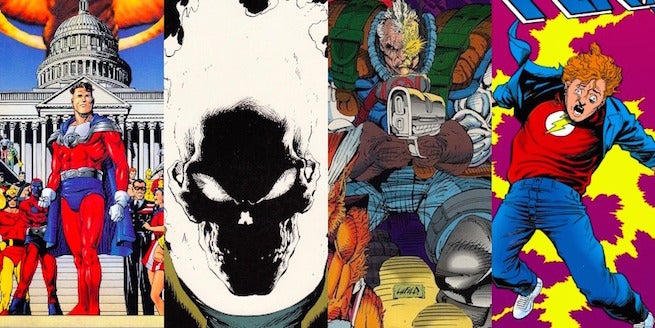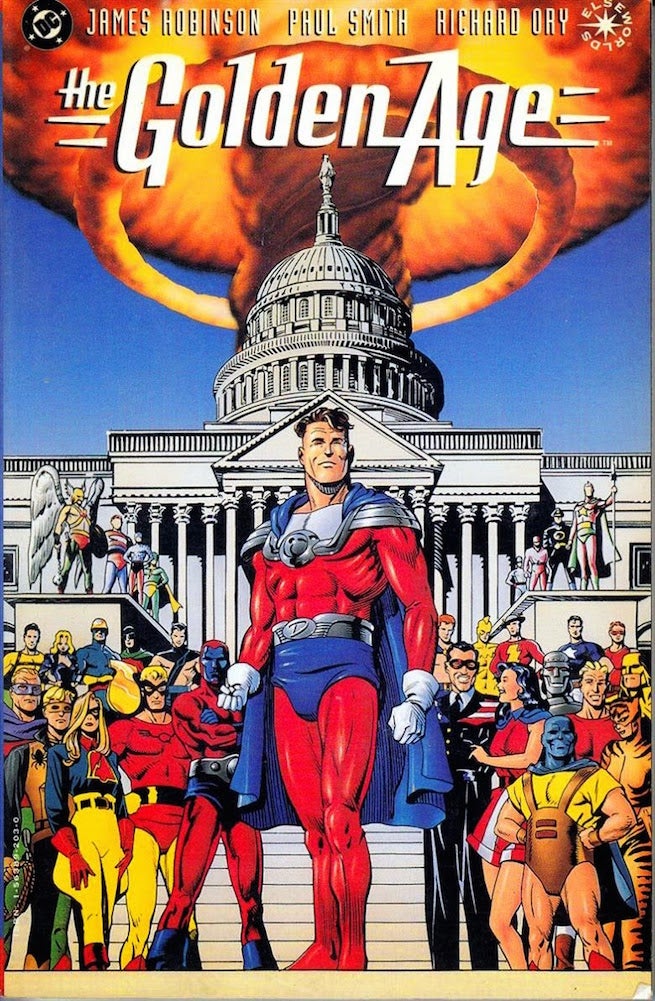Now that X-Files is hitting to the small screen after a 13-year hiatus, we here at ComicBook.com have 90’s fever. As the classic sci-fi series makes its triumphant return, it made us think of other 90s gems that are ready for a comeback— particularly from the world of comic books.
Videos by ComicBook.com
The 90s remain one of comics’ most controversial eras. Sales were at an all-time high, but they came artificially through gimmicks like holographic covers and more variants than we have today. Indeed, the marketplace was flooded with quickly-forgotten characters, unnecessary shake-ups, clones, and pouches. So many pouches. If that weren’t enough, some super famous artists decided to “revolutionize” the industry and launch a creator-owned movement that exists to this day. Yep, nothing happened in the 90s.
Jokes aside, while the decade was filled with moments that are best left buried, the 90s were also responsible for a number of creative trends ripe for a modern day revival a la the X-Files. Below, we run through the five that could justifiably make a comeback today.
5. Golden Age NostalgiaFor a decade that gets derided by egregious status quo upheavals and disregard for tradition, the 90s were chock full of acclaimed Golden Age character and concept celebrations. DC’s Kingdom Come and Marvel’s Marvels are two that are often cited as sentimental views of the past that still hold up against the modern era’s best offerings. Additionally, writer James Robinson updated Golden Age characters like Starman and the Justice Society of America to great acclaim.
Marvel Studios recently proved that modern audiences have a taste for the Golden Age with its post-WWII Agent Carter miniseries. Even in the four-color realm, the Big Two have prioritized taking new approaches with classic characters born in the Silver/Bronze Age. Sure, Earth-Two and the Invaders (both written by Robinson) sorta/kinda contain elements of yesteryear, but neither can be considered an unabashed celebration for the Golden Age like Robinson’s 90s Elseworlds classic, The Golden Age.
4. No, More Mutants
In the nineties, The X-Men apparently developed the mutant ability to print money. Once the famed X-Men #1 sold more than eight million copies, Marvel looked to develop anything they could with the mutant brand, making way for highly successful characters like Deadpool, Cable, Bishop and Gambit (like him or loathe him folks, the the Ragin’ Cajun is a big enough deal to get his own solo film), and team properties like X-Force and Generation X. And the Animated Series? That’s worth a list of its own.
For a number of reasons — many of them reportedly political with Fox Studio’s ownership of the X-Men movie franchise — Marvel has slowed its expansion of the X-universe. And don’t think that people haven’t noticed the recent marketing push behind the (Marvel Studios owned) Inhumans — a group of super heroes with inherent powers that aren’t technically “mutants.”
Expecting corporate entities to play nice at the expense of billions of dollars is about as naive as thinking world peace is attainable. But considering the number of comic book fans today who cite the 90s X-books as their gateway into the medium, we can at least pretend a modern day X-Men revival is possible.
3. Todd McFarlane Illustrating an Ongoing
The 90s had several big, bombastic artists, but Todd McFarlane arguably led the class. His Spider-Man series, which he scripted and illustrated, set several sales records when it shelves. Then, he proceeded to make history as one of the founding members of Image Comics. There, McFarlane developed one of the most important new comic book characters from the past 25 years: Spawn.
The cost of McFarlane’s meteoric rise was his schedule. McFarlane essentially outgrew the regular, deadline-driven grind of crafting an ongoing series, focusing his time and energy on big entrepreneurial pursuits, like his very own toy company, instead. But given the number of McFarlane’s recreations every month — just recently, variant covers for Silk and Spider-Gwen paid homage to McFarlane’s Amazing Spider-Man #300 — audiences still thirst for more McFarlane. If the creator ever announced that he was back in the game, even for something like a 12-issue maxi series a la Batman: The Long Halloween, he would probably rock the industry unlike anything its seen in years.
2. Mark Waid’s Flash
Even the most passionate Barry Allen fan would admit that The Flash comic series was at its best when Mark Waid scripted the book (starring Barry’s successor, Wally West) in the 1990s. Waid emphasized characterization from the onset with his “Year One” Kid Flash story, and matured Wally into a full-fledged superhero with arcs like “The Return of Barry Allen. He even developed what turned out to be a fan favorite romance in the coupling of Wally and Linda Park. Beyond the world of Wally, Waid’s run was famous for its celebration of speedster-lore, creating Impulse, Max Mercury, and The Speed Force.
With the Flash’s popularity at all time high thanks to a hit television show, now would be the perfect time to reunite Waid — a vet at this point — with the franchise that he made famous in the 90s. Waid could bring plenty of fresh insights to a brand new, post-New 52 Barry.
1. Glow-in-the-Dark Ghost Rider Covers by Mark Texeira
Gimmick covers get a bad rep from comic book fans, especially those who endured the endless onslaught of chromium, foil and polybags in the 90s. But Mark Texeira’s stunning glow-in-the-dark Ghost Rider #15 cover is a visual that would be an instant sensation regardless of its release date. With this cover, Tex created a lasting image — an iconic representation of a character who was at the peak of his popularity.
Unlike some other 90s gimmicks, the glow-in-the-dark ink enhanced the image from a really snazzy cover to arguably one of the most famous visuals from the era. With publishers currently pooling time and resources developing stunning variant cover art from titans like Alex Ross and Marcos Martin, something that pays homage to Tex’s game-changing Ghost Rider image needs a modern day revival. Or even better, get Tex himself to create a new glow-in-the-dark cover for Ghost Rider or another supernatural series.















